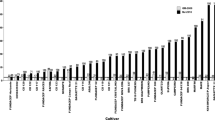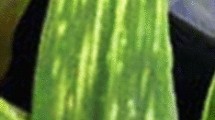Abstract
One-hundred and eleven cultivars of durum wheat (Triticum durum Desf.) representative of a large portion of the genetic diversity present in the world’s improved durum wheat gene pool were grown two seasons in a field with natural inoculum sources of soil-borne cereal mosaic virus (SBCMV) near Bologna (Italy). The materials were evaluated for resistance on the basis of symptom severity expression and Sbcmv concentration in leaves according to Das (double antibody sandwich) ELISA. Among the cultivars screened, two-year overall means ranged from 0.1 to 3.2 for symptom severity (on a 0 to 4 scale) and from 0.036 to 1.702 for ELISA absorbance values. Thirty-five cultivars showed relatively low ELISA values and very mild symptoms in both seasons. These relatively more resistant entries included cultivar Edmore and twelve of its derivatives, independently bred in Canada, France, Italy and the U.S. Twenty-one entries consistently gave ELISA values and symptom scores higher than that of cultivar Grazia, the susceptible control. Because of their extreme reactions to Sbcmv and wide adaptability, a number of the cultivars tested should prove useful for investigating the existence of pathotypes within SBCMV, and of diverse cultivar responses in regard to Furoviruses until recently considered as belonging to the same species, namely soil-borne wheat mosaic virus (SBWMV) and Chinese wheat mosaic virus (CWMV).
Zusammenfassung
In zweijährigen Versuchen wurden 111 Sorten von Hartweizen (Triticum durum Desf.), die einen großen Teil des verfügbaren Genpools repräsentieren, unter natürlichen Bedingungen auf Resistenz gegenüber dem Bodenbürtigen Getreidemosaikvirus (SBCMV) getestet. Der Anbau der Pflanzen erfolgte auf einem SBCMV-Befallsstandort in der Nähe von Bologna. Die Intensität der Symptomausprägung und die mit Hilfe des DAS-ELISA bestimmte Viruskonzentration in den Blättern dienten als Bewertungskriterien. Im Durchschnitt der beiden Jahre ergaben sich für die Sorten Boniturnoten zwischen 0.1 und 3.2 für die Symptomstärke (auf einer Skala von 0 bis 4) und Extinktionswerte zwischen 0.036 und 1.702. Insgesamt 31 Sorten wiesen höhere Extinktionswerte und Symptomstärke auf als der anfällige Standard „Grazia“; 35 Sorten zeigten dagegen deutliche Resistenz. Zu ihnen gehörten die Sorte „Edmore“ und 12 ihrer Abkömmlinge, die als Sorten unabhängig voneinander in Kanada, Frankreich, Italien und den Usa gezüchtet wurden. Die beobachteten großen Anfälligkeitsunterschiede der Sorten eröffnen die Möglichkeit, die Pathogenität bzw. Virulenz von Isolaten des SBCMV, des Bodenbürtigen Weizenmosaikvirus (SBWMV) und des Chinese wheat mosaic virus (CWMV) vergleichend zu prüfen.
Similar content being viewed by others
Literature
Bonnefoy, M., J. Boursereau, R. Chesneau, 1994: Comportment des variétés face aux virus de la mosaique du blé et de la mosaique jaune du blé. Proceedings, Workshop on Mosaics of Cereals Transmitted by Polymyxa graminis Led., Blois, France, 7–8 April 1994, 57–62.
Canova, A., A. Quaglia, 1960: Il mosaico del frumento. Informat. Fitopatol. 10, 206–208.
Canova, A., 1966: Ricerche sulle malattie da virus delle graminacee. III Polymyxa graminis Led. vettore del mosaico del frumento. Phytopathol. Medit. 5, 53–58.
Clark, M.F., A.N. Adams, 1977: Characteristics of the microplate method of enzyme-linked immunosorbent assay for detection of plant viruses. J. Virol. Meth. 34, 475–483.
Clover, G., D. Wright, C. Henry, 1999: Occurrence of Soil-borne wheat mosaic virus (SBWMV) in the United Kingdom. Proceedings, Fourth Symposium of the International Working Group on Plant Viruses with Fungal Vectors. Monterey, CA, USA, 5-8 October 1999, 105–108.
Diao, A.P., J.P. Chen, R. Ye, T. Zheng, S.Q. Yu, J.F. Antoniw, M.J. Adams, 1999: Complete sequence and genome properties of Chinese wheat mosaic virus, a new Furovirus from China. J. Gen. Virol. 80, 1141–1145.
Estes, A.P., M.K. Brakke, 1966: Correlation of Polymyxa graminis with transmission of Soil-borne wheat mosaic virus. Virology 28, 772–774.
Hunger, R.M., C.R. Armitage, J.L. Sherwood, 1989: Effects of Wheat soil-borne mosaic virus on hard red winter wheat. Plant Dis. 73, 949–952.
Huth, W., D.E. Lesemann, 1990: Wheat soil-borne mosaic virus isolated from rye in Germany. Proceedings, First Symposium of the International Working Group on Plant Viruses with Fungal Vectors, Braunschweig, Germany, August 21-24, 1990, 139–141.
Koenig, R., W. Huth, 2000: Soil-borne rye mosaic and European wheat mosaic virus: two names for a Furovirus with variable genome properties which is widely distributed in several cereal crops in Europe. Arch. Virol. 145, 689–697.
Koenig, R., W. Huth, 2003: Natural infection of wheat by the type strain of Soil-borne wheat mosaic virus in a field in Souhern Germany. Eur. J. Plant Pathol. 109, 191–193.
Maccaferri, M., C. Ratti, R. Tuberosa, C. Rubies-Autonell, V. Vallega, M.C. Sanguineti, 2005a: A durum wheat germ-plasm collection suitable for gene discovery via association mapping. Proceedings, International Symposium on Genomics-based Plant Germplasm Research, Beijing, China, April 25-28, 2005, 47–57.
Maccaferri, M., M.C. Sanguineti, E. Noli, R. Tuberosa, 2005b: Population structure and long-range linkage disequilibrium in a durum wheat elite collection. Mol. Breed. 15, 271–289.
Mckinney, H.H., 1923: Investigations of the rosette disease of wheat and its control. J. Agric. Res. 23, 771–800.
Moseman, J.G., H.H. Mckinney, C.W. Roane, 1954: Reaction of wheat varieties and selections to the soil-borne viruses in Southeastern United States. Plant Dis. Rep. 38, 19–24.
Nielsen, S.L., M. Nicolaisen, R. Koenig, W. Huth, 1999: First report of Soil-borne rye mosaic virus in rye in Denmark. Plant Dise. 83, 1074.
Ordon, F., W. Friedt, 2004: Genetic aspects of resistance to cereal viruses. In: Lapierre, H., Signoret, P.-A. (eds.): Viruses and Virus Diseases of Poaeceae (Gramineae), pp 170–172. INRA editions, Paris.
Ratti, C., A. Pisi, V. Vallega, C. Rubies-Autonell, 2005: Molecular characterization of Italian Soilborne cereal mosaic virus (SBCMV) isolates. %20Soil-borne%20cereal%20-%20Ratti%20et%20al.pdf.
Rubies-Autonell, C., V. Vallega, 1987: Observations on a mixed Soil-borne wheat mosaic virus and Wheat spindle streak mosaic virus infection in durum wheat. J. Phytopathol. 119, 111–121.
Rubies-Autonell, C., V. Vallega, C. Ratti, 2003: Reactions of cul-tivars of common wheat (Triticum aestivum L.) to Soil-borne wheat mosaic virus in northern Italy during 1996–97. Z. Pflan-zenkrankh. Pflanzensch. — J. Plant Dis. Protect. 106, 284–290.
Shirako, Y., N. Suzuki, R.C. French, 2000: Similarity and divergence among viruses in the genus Furovirus. Virology 270, 201–207.
Torrance, L., R. Koenig, 2005: Genus Furovirus. In: Fauquet, C.M., Mayo, M.A., Maniloff, J., Desselberger, U., Ball, L.A. (eds.): Virus Taxonomy, pp. 1027–1032. Elsevier Academic Press, San Diego and London.
Vallega, V., C. Rubies-Autonell, 1985: Reactions of Italian Triticum durum cultivars to Soil-borne wheat mosaic. Plant Dis. 69, 64–66.
Vallega, V., C. Rubies-Autonell, 1989: Ulteriori indagini sulla diffusione del virus del mosaico comune del frumento in Italia. Informat. Fitopatol. 39, 57–58.
Vallega, V., C. Rubies-Autonell, M. Turina, C. Ratti, S. Contoli, 1999: Reactions to SBWMV of durum wheat cultivars grown in northern Italy during 1995–96. Z. Pflanzenkrankh. Pflanzensch. — J. Plant Dis. Protect. 106, 284–290.
Vallega, V., C. Rubies-Autonell, C. Ratti, 2003: Reaction of durum wheat cultivars to mixed SBWMV and WSSMV infection in central Italy. Phytopathol. Medit. 42, 177–182.
Vallega, V., C. Rubies-Autonell, C. Ratti, L. Bianchi, 2004: Comportamento di cultivar di frumento duro e tenero rispetto al virus del mosaico comune del frumento (SBWMV): risultati di sei anni di prove. Proceedings, Giornate Fitopatologiche, Pescara, Italy, 4-6 May 2004, Vol. 2, 385–392.
Wiese, M.V., 1987: Compendium of Wheat Diseases. American Phytopathological Society, St. Paul, MN, USA.
Yang, J., J. Chen, Y. Cheng, M.J. Adams, 2001: Sequ ence analysis of a Soil-borne wheat mosaic virus isolate from Italy shows that it is the same virus as European wheat mosaic virus and Soil-borne rye mosaic virus. Sci. China Ser. C 44, 216–224.
Author information
Authors and Affiliations
Corresponding author
Rights and permissions
About this article
Cite this article
Ratti, C., Rubies-Autonell, C., Maccaferri, M. et al. Reaction of 111 cultivars of Triticum durum Desf. from some the world’s main genetic pools to soil-borne cereal mosaic virus. J Plant Dis Prot 113, 145–149 (2006). https://doi.org/10.1007/BF03356171
Received:
Accepted:
Published:
Issue Date:
DOI: https://doi.org/10.1007/BF03356171
Keywords
- durum wheat
- Edmore
- Elisa
- Polymyxa graminis Led.
- resistance
- soil-borne cereal mosaic virus
- soil-borne wheat mosaic virus




